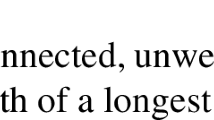Abstract
We study the problem of separating sublinear time computations via approximating the diameter for a sequence S=p 1 p 2 ⋅⋅⋅ p n of points in a metric space, in which any two consecutive points have the same distance. The computation is considered respectively under deterministic, zero error randomized, and bounded error randomized models. We obtain a class of separations using various versions of the approximate diameter problem based on restrictions on input data. We derive tight sublinear time separations for each of the three computation models via proving that computation with O(n r) time is strictly more powerful than that with O(n r−ε) time, where r and ε are arbitrary parameters in (0,1) and (0,r) respectively. We show that, for any parameter r∈(0,1), the bounded error randomized sublinear time computation in time O(n r) cannot be simulated by any zero error randomized sublinear time algorithm in o(n) time or queries; and the same is true for zero error randomized computation versus deterministic computation.
Similar content being viewed by others
References
Badoiu M, Czumaj A, Indyk P, Sohler C (2005) Facility location in sublinear time. In: Proceedings of 32nd annual international colloquium on automata, languages and programming, pp 866–877
Chazelle B, Liu D, Magen A (2005a) Sublinear geometric algorithms. SIAM J Comput 35:627–646
Chazelle B, Rubfinfeld R, Trevisan L (2005b) Approximating the minimum spanning tree weight in sublinear time. SIAM J Comput 34:1370–1379
Chen L, Fu B (2007) Linear and sublinear time algorithms for the basis of Abelian groups. Electron Colloq Comput Complex TR07-052
Czumaj A, Sohler C (2004) Estimating the weight of metric minimum spanning trees in sublinear-time. In: Proceedings of the 36th annual. ACM, Symposium on theory of computing, pp 175–183
Czumaj A, Ergun F, Fortnow L, Magen INA, Rubinfeld R, Sohler C (2005) Sublinear approximation of euclidean minimum spanning tree. SIAM J Comput 35:91–109
Drineas P, Kannan R (2001) Fast Monte-Carlo algorithms for approximate matrix multiplication. In: Proceedings of the 42nd IEEE Symposium on Foundations of Computer. Science, pp 452–459
Feige U (2006) On sums of independent random variables with unbounded variance and estimating the average degree in a graph. SIAM J Comput 35:964–984
Fischer E (2001) The art of uninformed decision: a primer to property testing. Bull EATCS 75:97–126
Fu B, Chen Z (2008) Sublinear time width-bounded separators and their applications to the protein side-chain packing problem. J Comb Optim 15(4):387–407
Goldreich O (1997) Combinatorial property testing (a survey). In: Pardalos P, Rajasekaran S, Rolim J (eds) Proceesdings of the DIMACS workshop on radnomziation methods in algorithm design. DIMACS series in discrete mathematics and theoretical computer science, vol 43, pp 45–59
Goldreich O (2002) Property testing in massive graphs. In: Abello J, Pardalos PM, Resende M (eds) Handbook of massive data sets, pp 123–147
Goldreich O, Ron D (2000) On testing expansion in bounded-degree graphs. Technical Report 00-20, Electronic Colloquium on Computational Complexity. http://www.eccc.uni-trier.de/eccc/
Goldreich O, Ron D (2005) Approximating average parameters of graphs. Technical Report 05-73, Electronic Colloquium on Computational Complexity. http://www.eccc.uni-trier.de/eccc/
Kumar R, Rubinfeld R (2003) Sublinear time algorithms. SIGACT News 34:57–67
Goldreich SGO, Ron D (1998) Property testing and its connection to learning and approximation. J ACM 45:653–750
Ron D (2001) Handbook of randomized algorithm. Bull EATCS II:597–649
Trench WF (1978) Advanced calculus. Harper & Row, New York
Zhao Z, Fu B (2007) A flexible algorithm for pairwise protein structure alignment. In: Proceedings international conference on bioinformatics and computational biology
Zimand M (2007) On derandomizing probabilistic sublinear-time algorithms. In: Proceedings of the 22nd IEEE conference on computational complexity, pp 1–9
Author information
Authors and Affiliations
Corresponding author
Additional information
This research is supported in part by the National Science Foundation Early Career Award 0845376.
Rights and permissions
About this article
Cite this article
Fu, B., Zhao, Z. Separating sublinear time computations by approximate diameter. J Comb Optim 18, 393–416 (2009). https://doi.org/10.1007/s10878-009-9248-3
Published:
Issue Date:
DOI: https://doi.org/10.1007/s10878-009-9248-3




